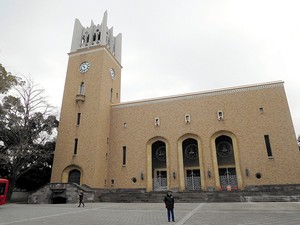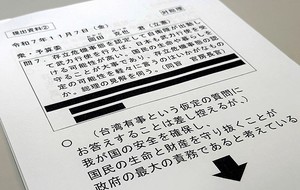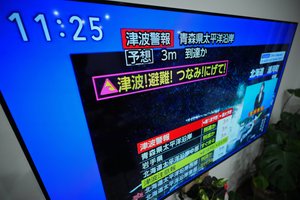August 17, 2024 at 15:47 JST
 A beach in Shirahama, Wakayama Prefecture, is closed on Aug. 10 after a megaquake advisory was issued on Aug. 8. (Asahi Shimbun file photo)
A beach in Shirahama, Wakayama Prefecture, is closed on Aug. 10 after a megaquake advisory was issued on Aug. 8. (Asahi Shimbun file photo)
After a week of uneasiness following the Japan Meteorological Agency’s first-ever Nankai Trough advisory, which called for caution against a possible huge earthquake, the broad implications and impact of that action should be rigorously reviewed.
Although no large earthquake occurred during the period, it does not mean that one will not strike soon. Japan is always at risk of a major earthquake anywhere and anytime.
This is an opportunity to examine how best to communicate information about earthquake risks.
The advisory was issued following a magnitude-7.1 quake that occurred Aug. 8. The temblor’s epicenter was in the Hyuganada Sea, which lies in the westernmost part of the estimated hypocentral region of a long-anticipated megaquake along the Nankai Trough, an ocean-floor trench that runs along the Pacific coast from the Tokai to Kyushu regions.
The advisory was based on records of past megaquakes around the world. Over the past century or so, 1,437 earthquakes with a magnitude-7.0 or more have struck. In six of these cases, an earthquake of magnitude-8.0 or greater occurred within a week of a magnitude-7.0 level temblor striking.
The advisory, which is officially called “megathrust earthquake attention,” targeted 707 municipalities from Okinawa Prefecture to Ibaraki Prefecture, calling for a check on usual preparedness.
Some local governments established evacuation centers and prepared for the evacuation of the elderly. Tokaido Shinkansen services operated at reduced speeds in some sections, but that was the decision of the operator, Central Japan Railway Co. (JR Tokai). There is no standard response for nuclear power plants.
Although there was no significant social disruption this time, numerous people were affected by canceled trips and other events. It served as an opportunity to check earthquake preparedness, but it might not be the same next time.
The Cabinet Office says it will consider the need to improve the system’s operation. A fundamental reevaluation is clearly necessary.
One issue is what kind of information should be issued and in what manner. The agency issued emergency information stating, “Earthquakes are several times more likely to occur (in the trough),” and “The probability of occurrence is once in several hundred times.” When it lifted the advisory, the agency warned that seismic activity in the Hyuganada Sea is “quite active.”
Confusing messages can spread uncertainty among residents and local governments. It is also crucial to reexamine the content and explanations of the disaster prevention measures that the agency urged communities to take. The agency should avoid misconceptions that it would always issue such information before an earthquake.
This time again, the agency reiterated its alarming estimate that a Nankai Trough earthquake has a “70-80 percent chance of occurring within 30 years,” but this figure is inflated by a unique calculation method that differs from the standard approach to estimating such probabilities. High probabilities of major seismic events related to the Nankai Trough should not be seen as information indicating the relative seismic safety of other regions.
Another issue is the level of alert. In “han ware” (half-breaking) cases where a part of the expected focal area experiences a magnitude-8.0 level earthquake, instead of the impact between the tectonic plates over the entire focal region, a major earthquake “alert” would be issued for the remaining areas. In such cases, coastal areas would be required to evacuate, significantly increasing the overall impact.
Just as the 1944 Showa Tonankai earthquake (magnitude-8.2) was followed by the Showa Nankai earthquake (magnitude-8.4) about two years later, a prolonged state of uncertainty could continue.
Previously, in regard to a Tokai megaquake anticipated to occur off the Pacific coast of central Japan, the agency was supposed to declare a warning based on prediction, to strongly regulate social activity, but this alert program was essentially abolished after it was decided that the ability of earthquake science did not measure up for the requirements of the system.
The focus of the government’s earthquake policy has shifted from prediction to disaster preparedness and mitigation. It is imperative to develop an effective strategy to minimize overall damage when an earthquake occurs.
Earthquakes occur without warning. We must not forget that preparedness is always necessary nationwide.
--The Asahi Shimbun, Aug. 17




















A peek through the music industry’s curtain at the producers who harnessed social media to help their idols go global.
A series based on diplomatic documents declassified by Japan’s Foreign Ministry
Here is a collection of first-hand accounts by “hibakusha” atomic bomb survivors.
Cooking experts, chefs and others involved in the field of food introduce their special recipes intertwined with their paths in life.
A series about Japanese-Americans and their memories of World War II